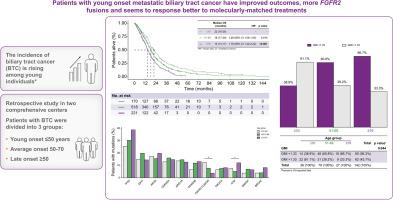年轻发病的胆道癌:特征、治疗模式和患者预后
IF 7.5
1区 医学
Q1 GASTROENTEROLOGY & HEPATOLOGY
引用次数: 0
摘要
背景和目的胆道癌(BTC)的发病率在年轻人(≤50岁)中呈上升趋势。我们旨在探讨年轻发病BTC (YO-BTC)的临床、治疗、分子特征和结局。方法在Gustave Roussy(法国)和Vall d 'Hebron肿瘤研究所(西班牙)治疗的组织学证实的BTC患者分为YO-BTC(年龄≤50岁)、AO-BTC(年龄51-69岁)和迟发型(LO-BTC,年龄≥70岁)。主要终点是总生存期(OS)。次要终点是生长调节指数(GMI),例如,靶向治疗系的无进展生存期(PFS)与n-1系的PFS之比。结果1023例BTC患者中,YO-BTC 184例(18%),AO-BTC 561例(54.8%),LO-BTC 278例(27.2%)。YO组转移患者的中位生存期(22个月;95% CI 18 - 26)比AO组(18个月;95% CI 17-20; p = 0.010)或LO组(15个月;95% CI 13-17; p <0.001)更长,尽管YO- btc的肿瘤负担更高。FGFR2融合在YO-BTC中更常见(12% vs. 5.7% AO和4.3% LO; p = 0.038)。YO- btc患者在二线或二线接受更多靶向治疗(YO、AO和LO分别为48%、37%和29%;p = 0.020)。在接受分子匹配治疗的患者中,YO- btc的GMI >;1.33发生率更高(YO、AO和LO分别为61.1%、39.2%和33.3%;p = 0.044),但PFS和OS没有差异。结论YO-BTC患者转移性预后较好。YO-BTC组丰富了FGFR2融合,突出了基于精确肿瘤学方法的机会。影响和意义该研究强调了调查胆道癌症年龄相关差异的科学依据,揭示了年轻发病的胆道癌症患者具有改善的生存结果和更高的可操作分子改变发生率,特别是FGFR2融合。医生可以通过将分子谱分析和靶向治疗纳入年轻患者的早期治疗计划来应用这些结果,从而潜在地改善他们的预后和生活质量。然而,重要的是要考虑到研究的局限性,如回顾性设计和潜在的选择偏差,以避免过度概括,并确保研究结果在临床实践和未来的研究中得到适当的应用。本文章由计算机程序翻译,如有差异,请以英文原文为准。

Young-onset biliary tract cancers: Characteristics, treatment patterns, and patient outcomes
Background & Aims
The incidence of biliary tract cancers (BTC) among young individuals (≤50 years) is currently rising. We aimed to investigate the clinical, therapeutic and molecular characteristics and outcomes of young-onset BTC (YO-BTC).
Methods
Patients with histologically confirmed BTC treated at Gustave Roussy (France) and Vall d’Hebron Institute of Oncology (Spain) were categorized as YO-BTC (≤50 years old), average-onset (AO-BTC; 51-69 years old), and late-onset (LO-BTC; ≥70 years old). The primary endpoint was overall survival (OS). The secondary endpoint was the growth modulation index (GMI), e.g., the ratio of progression-free survival (PFS) with the targeted therapy line to the PFS of the n-1 line.
Results
Among 1,023 patients with BTC, 184 (18%) had YO-BTC, 561 (54.8%) had AO-BTC, and 278 (27.2%) had LO-BTC. Median OS in metastatic patients was longer in the YO group (22 months; 95% CI 18–26) than in the AO group (18 months; 95% CI 17–20; p = 0.010) or LO group (15 months; 95% CI 13–17; p <0.001), despite a higher tumor burden in YO-BTC. FGFR2 fusions were more frequent in YO-BTC (12% vs. 5.7% AO and 4.3% LO; p = 0.038). Patients with YO-BTC received more targeted therapies as second or later lines (48%, 37%, and 29% for YO, AO, and LO; p = 0.020). Among patients receiving molecular-matched treatments, GMI >1.33 was more frequent in YO-BTC (61.1%, 39.2%, and 33.3% for YO, AO, and LO; p = 0.044), although no differences in PFS or OS were observed.
Conclusion
Patients with YO-BTC have improved outcomes in the metastatic setting. The YO-BTC group is enriched for FGFR2 fusions, highlighting opportunities for precision oncology-based approaches.
Impact and implications
The study underscores the scientific justification for investigating age-related differences in biliary tract cancers, revealing that patients with young-onset biliary tract cancer have improved survival outcomes and a higher prevalence of actionable molecular alterations, particularly FGFR2 fusions. Physicians can apply these results by incorporating molecular profiling and targeted therapies earlier in the treatment plan for younger patients, potentially improving their prognosis and quality of life. However, it is crucial to consider the study's limitations, such as the retrospective design and potential selection bias, to avoid overgeneralization and ensure appropriate application of the findings in clinical practice and future research.
求助全文
通过发布文献求助,成功后即可免费获取论文全文。
去求助
来源期刊

JHEP Reports
GASTROENTEROLOGY & HEPATOLOGY-
CiteScore
12.40
自引率
2.40%
发文量
161
审稿时长
36 days
期刊介绍:
JHEP Reports is an open access journal that is affiliated with the European Association for the Study of the Liver (EASL). It serves as a companion journal to the highly respected Journal of Hepatology.
The primary objective of JHEP Reports is to publish original papers and reviews that contribute to the advancement of knowledge in the field of liver diseases. The journal covers a wide range of topics, including basic, translational, and clinical research. It also focuses on global issues in hepatology, with particular emphasis on areas such as clinical trials, novel diagnostics, precision medicine and therapeutics, cancer research, cellular and molecular studies, artificial intelligence, microbiome research, epidemiology, and cutting-edge technologies.
In summary, JHEP Reports is dedicated to promoting scientific discoveries and innovations in liver diseases through the publication of high-quality research papers and reviews covering various aspects of hepatology.
 求助内容:
求助内容: 应助结果提醒方式:
应助结果提醒方式:


